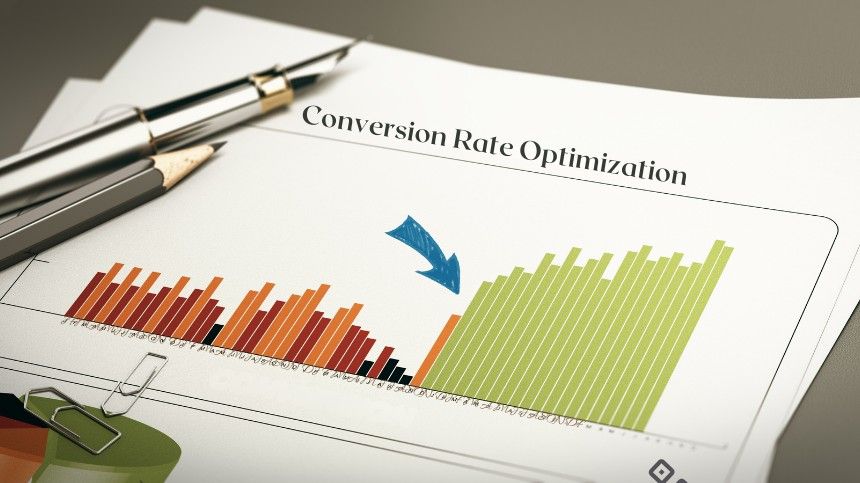
Every month, hundreds of people visit your stunning website. Your Google advertisements are generating traffic, your SEO is working, and yes, people are finding you online.
But here’s what’s keeping you awake at night—most of these visitors are just … leaving. They’re clicking around for a few minutes and then vanishing into the digital ether without making a purchase or even reaching out.
Sound familiar? You’re not battling this alone.
The sad truth is, if you’re like most websites, only 1-3% of users convert on your site (with the average conversion rate being 2.35% based on studies by Invesp). That’s right: For every 100 people who come to your website, 97 leave without doing anything at all. Enough to make any entrepreneur want to pull their hair out!
But what if I told you there is a deliberate approach to boosting these numbers in a big way? That’s where conversion rate optimization comes in.
What Exactly Is Website Conversion Optimisation?
Conversion rate optimisation, also known as CRO, aims to increase the percentage of your website visitors who complete the desired action. That action could include finalising a purchase, submitting a contact form, subscribing to a newsletter, or downloading a brochure.
Here’s the low-down: if marketing is pushing people through your door, CRO is making sure they’re not just leaving empty-handed.
The best part about website conversion optimisation is that to grow your business, you don’t need more traffic – simply convert more of the attendees to your site. According to studies, organisations invest 92 times more in customer acquisition than in CRO (only $1 for every $92 spent), signalling the vast possibility of using resources more effectively.
The Psychology Behind Why People Don’t Convert
Before delving into the specifics, it’s crucial to understand the mindset of your visitor upon landing on your site. Knowing this is vital for effective CRO.
The majority of people landing on your website are in “browsing” mode —they’re comparing options, doing research and deciding whether or not they can trust you with their cash. Your role is to shepherd them from insecurity into confidence.
Here’s the intriguing part: The No. 1 challenge to conversions is almost never price or product quality. It’s friction and doubt.
- Friction: Anything that makes it more difficult to get something done. Complex navigation, excessive form fields, long page load times, or ambiguous calls-to-action are examples of friction. The less friction present, the more conversions you will achieve with a satisfactory product or service.
- Doubt: On trust and credibility. Visitors keep trying to figure it out: “Is this real? Will they deliver? What if something goes wrong?” Your website should answer these questions head-on.
Overcome these two psychological roadblocks and you’ll see a significant increase in the percentage of visitors who take action.
The Elements That Actually Matter for Conversions
Now, let’s discuss some of the minutiae in what gets visitors to convert. A few of the factors—based in large part on years of testing and analysis—all consistently affect conversion rates:
- Your headline and value proposition
Within seconds of landing on your page, people should know what you do and why they’re supposed to be interested. Most websites are self-centred rather than dealing with the desires of the visitor. Instead of “We are Perth’s premier web design agency,” try “Get a website that actually brings in new customers.”
- Trust signals
Customer testimonials, client logos, security badges, and contact information can make or break your conversion rate. Here’s a hint: the actual quality of your website design is your trust signal alone. A professional-looking and fast-loading site automatically makes you look more trustworthy.
- Call-to-action (CTA) buttons
The text, colour, size, and location of them all play a role even more than you’d believe. Instead of generic phrases like “Submit” or “Click Here”, try using action-oriented language such as “Get Your Free Quote”, “Download the Guide”, or “Start Your Project”.
- Social proof
Instead of “Thousands of happy customers,” show specific examples. Real testimonials with names and photos work better than generic quotes. Case studies demonstrating actual results are pure gold.
- Mobile experience
These days, mobile devices generate most of the traffic, so your conversion process must function flawlessly on small screens. This means bigger buttons, simpler forms, and faster loading times across all devices.
When you nail these factors, the number of visitors taking action on the website will go up significantly. For even more robust results, study landing pages for conversions.
Common Conversion Killers to Avoid
One of the things about conversion optimisation is that knowing what to do is great; sometimes knowing what not to do is just as important. Over time, we’ve noticed some common trends that tend to kill conversion rates on just about every type of website.
I want to share some of those conversion killers that we still get hit with:
- Forms that require too much information up front: People are protective of their personal details, especially early on. When you request information, ask for only what you absolutely need to take the next step.
- Weak or nonexistent contact information: If site visitors can’t readily determine a phone number, physical address and email, they’ll assume that you’re not a real business.
- Slow loading pages: Nothing kills conversions more than slow loading pages. If your pages load in longer than 3 seconds, you are losing sales.
- Uncertain pricing or next steps: You don’t want to make people go through contortions to figure out what something costs or what they should do next. Confusion kills conversions every time.
- Generic, stock-photo-filled websites: If you look like everyone else, your conversion rate is going to suck. Your site should present your business (not the one from the photo library!)
By avoiding these common pitfalls, you will gain a situational awareness advantage over most of your competitors who still do not understand this concept.
How to Actually Increase Website Conversions
Right, so now that we know what not to do, let’s talk about practical strategies that actually work.
- Start with user experience research: Watch screen recordings, conduct surveys, or check analytics to see where people drop off.
- Simplify your navigation: Make it obvious how to find important information. If visitors can’t reach your contact page within seconds, you’ve lost them.
- Optimise your forms: Break long forms into steps, use smart defaults, and make sure they work on mobile devices.
- Create urgency where appropriate: Limited-time offers or stock levels encourage faster action. Just don’t be fake about it.
- Test different versions: A/B testing is reliable for improving conversions. Test headlines, button colours, or page layouts.
- Focus on local trust signals: Show local phone numbers, addresses, and testimonials from local customers to boost Perth business conversions.
These strategies work because they’re based more on understanding real user behaviour than guesswork.
The Technical Side of CRO
It’s precisely that which matters: “The right technical foundation.” The code, infrastructure, and all technical setups—everything that made up your site—can have such a big impact on conversions.
- Pagespeed optimisation is non-negotiable for conversions. Optimise images, minimise codes, and choose reliable hosting. Google’s PageSpeed Insights offers tailored suggestions. Learn how to boost the speed of your site.
- Mobile responsiveness: Enable a conversion-friendly interface regardless of touch device. Buttons must be easy to tap, text must be readable without zooming, and forms must work seamlessly.
- SSL certificates and security features: Are essential for building trust, and not just for SEO. That padlock icon informs visitors their information is secure.
- Proper analytics setup: Please record what is effective and what is not. Understand which pages people look at, for how long, and where they drop off.
Establishing a solid technical foundation is crucial, as a shaky foundation can lead to the collapse of all other aspects.
Industry-Specific CRO Strategies
Conversion optimisation requires different methods for different kinds of businesses. What an eCommerce store does is not what a professional services firm does.
- For service-based businesses
The objective is typically to obtain leads, not to produce instant sales. This means focusing on contact forms, phone calls, and consultation requests. A central pillar of a CRO strategy should be trust-building and ensuring that it is simple for potential customers to take that first step.
- For eCommerce sites
You’re working on shopping cart abandonment, product page optimisation, and checkout flow improvements. This includes showing upfront shipping costs, providing guest checkout options, and prominently displaying security badges.
- For B2B companies
A longer sales cycle means your CRO strategy should nurture the leads over time. This might involve offering downloads of valuable content, webinar registrations, or free consultations.
Measuring and Tracking Your CRO Success
You can’t manage what you don’t measure. When it comes to serious CRO campaigns, you simply need to have effective tracking in place.
- Conversion tracking: Don’t just track the form submits or sales. Track microconversions, such as email signups, downloads or video views. These smaller actions typically result in larger conversions afterwards.
- Heat mapping tools: Just where are people clicking, how far down the page do they scroll, and what do they largely ignore? This visual information exposes issues that traditional analytics overlook.
- User sessions: View real recordings of people navigating your site. You will soon find frustrating use-cases and you’ll figure out why people leave without converting.
- Ongoing reporting and analysis: Implement monthly reports following major conversion metrics, benchmarking against previous times so that you will see trends and opportunities.
Without proper measurement, you are just flying blind on what works — and that’s not a way to do business.
Working with CRO Professionals
You can do a lot on your own, but working with experts will speed things up. Seek out web designers and digital marketing professionals who “get” the technical and psychological dimensions of conversion optimisation.
The top CRO professionals will work to audit your existing site first to see where the biggest opportunities lie. They would then compile a testing plan focusing on types of changes (in terms of potential impact and ease of deployment).
If you are seeking assistance with your website conversion optimisation, or any other service, be sure to look for evidence of real results! Case studies, real client testimonials, and an easy-to-understand process are all positive signs. Reach out to our web design team to discuss how we can help your website perform better in conversions.
Getting Started with Your CRO Journey
Are you interested in the benefits of a linked article that improves your SEO and conversion readiness? Begin at the very beginning. Ensure that your site loads quickly, provides a fantastic user experience on mobile devices, and clearly communicates the benefits to potential customers.
After that? Start with small changes in strategy as well as redecorating your site and just assess how things go.
Remember: conversion rate optimisation is an ongoing process, not something you complete once. The top-performing sites are always trying different methods to improve and refine their approaches, depending on data feedback from users and customers.
The good news? Even relatively minor improvements in conversation rates can have a significant effect on your bottom line. If you are already converting web visitors at 2% and that grows to 3%, then that number may add up rather quickly indeed, without spending one more cent of advertising dollars.
Focusing on both driving traffic and converting it into paying customers can be a powerful way to help your business succeed.
You want to learn how conversion rate optimisation can take your website’s performance to the next level? The team at SLINKY Web Design combines award-winning web design with proven CRO strategies to help Perth businesses convert more visitors into clients. Contact us today and let us examine how we can transform your website for better results!










